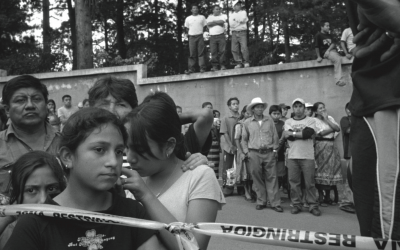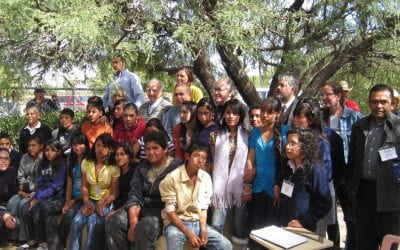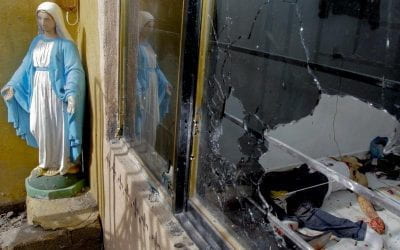Investigating Organized Crime
InSight Crime
Medellin, Colombia, February 2009. Two journalists, with more than twenty years of experience between them covering Latin America, were engaging in a familiar lament over a couple of beers. Nobody was paying for serious investigation of organized crime in Latin America on the ground. Coverage was now limited to gory decapitations in Mexico. One of the journalists had just returned from Itagüí prison, where he had chalked up hours of interviews with former right-wing paramilitaries on the drug trade past and present. He fretted about whether anyone would ever be interested in publishing it. The other, after ten days in the Colombian mountains, had just sought to pitch a story about Marxist rebels adapting to the new conditions of the civil conflict, only to be told by a London newsdesk that they were certain the fighting was pretty much over in Colombia. Thus, InSight Crime <www.insightcrime.org>, was born.
In 2001, there were at least sixty foreign correspondents writing in English, most of them staffers, reporting on the Colombian civil conflict and drug trafficking. Today you would be hard pressed to name ten decent freelancers here. The story is the same across the region, even in Mexico. Coverage of organized crime and the drug trade in the Americas is now largely confined to the bitter fighting between rival drug cartels in Mexico and the violence this generates. Yet Mexico is only the last stage in a story that starts with coca crops of the Andes and spreads in every direction across Latin America. Now perhaps more than ever, a real understanding of the threat that organized crime presents to Latin America is necessary and somebody has to put all of this in a regional context as the very nature of transnational organized crime is that it infects many different countries with the same plagues. InSight Crime believes that with study you can anticipate what is going to happen in one place by looking at what has already occurred in another.
The violence in Mexico is what is making the headlines, and the debate about whether there is some kind of “criminal insurgency” on the U.S. doorstep. Yet the homicide rate in Mexico, 18 per 100,000 of the population in 2010, does not compare to Colombia (38), or Venezuela (48), let alone the Northern Triangle of El Salvador (66), Guatemala (41) or Honduras, the latter with a staggering 78 homicides per 100,000.
The murder rate does not tell the whole story, but certainly indicates levels of criminality, impunity and the effectiveness of the security forces. Latin America has the highest homicide rates in the world, and the situation in many places is getting worse. Pressure on organized crime in Colombia and Mexico has simply squeezed transnational criminal organizations (TCOs) into Venezuela and Guatemala and further afield. Northern Guatemala already has an established presence of Mexican TCOs <http://www.insightcrime.org/specials/zetas-in-guatemala>. with Colombian TCOs having set up shop in Panama and Venezuela.
As security forces pressure certain drug trafficking methods or routes, the TCOs find new ones. Transshipment nations like Honduras and Belize in Central America are under serious threat, while several Caribbean nations are seeing their levels of criminality and violence increase as they become staging points for cocaine heading northwards (Trinidad and Tobago, for example). Whereas in the 1980s and early 1990s planes carried up to ten tons of cocaine each trip, aerial interdiction has forced the cartels below the waves, with the use of drug submarines.
Yet there is little research being done on the TCOs or the effects they are having region-wide. Here in Medellin, one of the InSight Crime bases, everyone can tell you about Pablo Escobar, who turned this vibrant Andean city into one of the criminal capitals of the world in the 1980s. However today few people would be able to tell you anything about Maximiliano Bonilla Orozco, alias Valenciano, or Erick Vargas Cárdenas, alias Sebastián, Escobar’s successors, who are slugging it out for control of the Medellin underworld. The Colombian TCOs, among them the Marxist rebels of the Revolutionary Armed Forces of Colombia (FARC), are working directly with Mexican cartels.
The real threat at a local level is the fact that the TCOs pay their local partners not in cash, but in cocaine, feeding the local consumption of drugs, and the violence that inevitably accompanies it. In every place that the TCOs operate they develop alliances with local criminal gangs, which with time increase in sophistication and power. Many make the leap into serious organized crime and develop into threats to local law enforcement and even national security. Every country the drugs pass through see elements of the security forces corrupted, the justice system put under pressure and politicians bribed.
InSight Crime is attempting to trace the major players in organized crime, profile the leaders, study the evolution of the groups and networks they lead, follow the response of the different states that are threatened and where possible, send up warning flares. Our current warnings are to keep an eye on tiny Belize and be prepared for yet more violence in Honduras. The Caribbean is another growing hot spot, as indications are that TCOs are again looking to exploit routes through the network of islands here.
InSight Crime is celebrating its first birthday. Without the help of Open Society Foundations, we would not have got off the ground and be heading into a second year, but this money is running out and we are scrambling, through consultancy work, to be self sustaining, something which will be an endless struggle. That there is interest in the challenges of organized crime in the region is clear, but it is limited to experts and international law enforcement. We have been surprised by the high number of the visits to the site (just over 3,000 per day), and the constant barrage of emails asking for more information, advice or simply thanking us for the work we are doing. We in turn thank the local journalists, academics and contributors, most of whom are living in the trenches of the drug war. They take risks every single day to report on this never-ending war, and suffer the same frustrations as we do: reader apathy and bankrupt media organizations that prefer to run the latest Hollywood divorce story rather than to investigate how organized crime is placing an entire region under siege.
Spring 2012, Volume XI, Number 3
Jeremy McDermott is the co-director of InSight Crime; he lives in Medellin, Colombia.
Related Articles
Lessons from Colombia for Mexico?
One of the things that struck me most on my last trips to Colombia in January and June 2011 was the great level of optimism regarding the country’s security accomplishments after several…
Making a Difference: Grassroots Educational Change in Mexican Public Schools
Middle-school teacher Miguel Hernández, from the state of Querétaro in Mexico, is learning math. Surprisingly, his teacher is Blanca de la Cruz, a ninth-grade student from a small rural…
Mexico’s Challenges
When Felipe Calderón took oath as Mexico’s president, he identified security policy—particularly a struggle against criminal organizations—as the flagship policy of his administration. Like…





